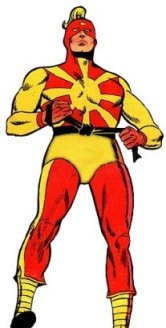First mentioned, to my knowledge at least, in the pages of The Great Comic Book Heroes by Jules Feiffer is the legendary tale of how a Golden Age comic book was created in a single weekend, one in which the survival of the artists themselves was in some meager doubt. The comic book in question is the second issue of Daredevil Comics from Lev Gleason Publishing which hit the stands in the summer of 1941.
This tale has been told in several venues and even immortalized in fictional form in Michael Chabon's The Amazing Adventures of Kavalier and Clay. It kindles the imagination for a number of reasons, one it speaks to the helter skelter nature of comic book creation in its infant days, how raw energy often substituted for craftsmanship and care. How comics are an art, but they are also a product for sale which are fashioned within the demanding rigors of a deliberate and often unforgiving schedule.
Things have changed nowadays with comics having been reduced to a minor art and no longer a true mass medium, but throughout most of the history of the comic book, we fans want our comics to be good of course, but first and foremost we wanted them to simply be. We were eager to buy and publishers were sure to have it available so that the opportunity would not slip by.
I most recently ran across this legendary yarn in the biography Jerry Robinson - Ambassador of Comics, in which the story is told from the perspective of one of the men who was there on that prodigious weekend of March seventeenth. The story goes that a gaggle of young energetic artists and writers assembled at a sparsely furnished New York City apartment rented for that very reason. Charles Biro has learned that because of a need to use up their allotment of paper they needed a new comic ready for the presses and they needed it by the following Monday. To that end the talent was assembled and given largely carte blanche to create stories to fill the needed sixty-four pages.
Charles Biro would handle the lead feature Daredevil which accounted for the first thirteen pages. After that it was every man for himself as a ferocious binge of creation ignited. Bernard Klein created "The Whirlwind" about boxing, and other talents such as George Roussos and Dick Wood contributed "Nightro". Jerry Robinson himself created "London", a masked hero who was involved with the Blitz. Dick Briefer wrote and drew "Real American". Others did what they could, creating characters, some which would only appear in this single comics, in the mad rush to hit the deadline.
 |
| New York City under snow in March, 1941 |
The story then takes a dangerous turn when, while the artists are furiously creating in the apartment a heavy winter storm strikes the city, closing down everything save the subways, and forcing stores to close. Getting something to eat was problematic, and Bernie Klein was sent off into the white wastes to find sustenance. He returned hours later with only some eggs and a can of beans. The artists, desperately pried loose ceramic bathroom tiles and created a fire to cook the eggs and heat the beans, which staved off fits until the streets quickened with life once again.
Needless to say, the book was completed and assembled and sent to the printer on time. This story shows not only the ruthless nature of publishing but also the wild bristling energy which informed the earliest days of comics, an art form still in its infancy and eager to please the audience which fondled it with such devotion.
The story is made more poignant in that Bernie Klein, a talent with much promise was one of those multitude of young men who lost their lives defeating the Axis powers on the battlefields of Europe. His death made all the more tragic, because as the legendary weekend showed he was like so many of his peers a man filled with spirit and life.
To read this epic iconic comic in its glorious totality check this out. They don't make like that anymore.
Rip Off











I always thought that story was about the book-length Torch/Sub-mariner battle (a 60 page story over a weekend, a bit crazier than separate stories being produced simultaneously). It's mentioned both in Steranko's History and that Les Daniels book on Marvel, quoting from Bill Everett, I don't doubt Robinson's word; I bet this is Feiffer's source.(Does Robinson actually mention Feiffer?) But I wonder how often this happened in those early days. Al Williamson told a hilarious story about how he and Angelo Torres had to produce an issue of the Cheyenne Kid overnight, mostly because they'd been goofing off instead of working.
ReplyDeleteI've run across that tale of the Human Torch story too. Likely this kind of thing happened more than once during the heyday, a time filled with energetic artists eager to get over in whatever way possible and editors always looking for the next big hit. In later years we get the more industrial feel of "Diverse Hands" when comics had to be produced in a hurry.
DeleteRip Off